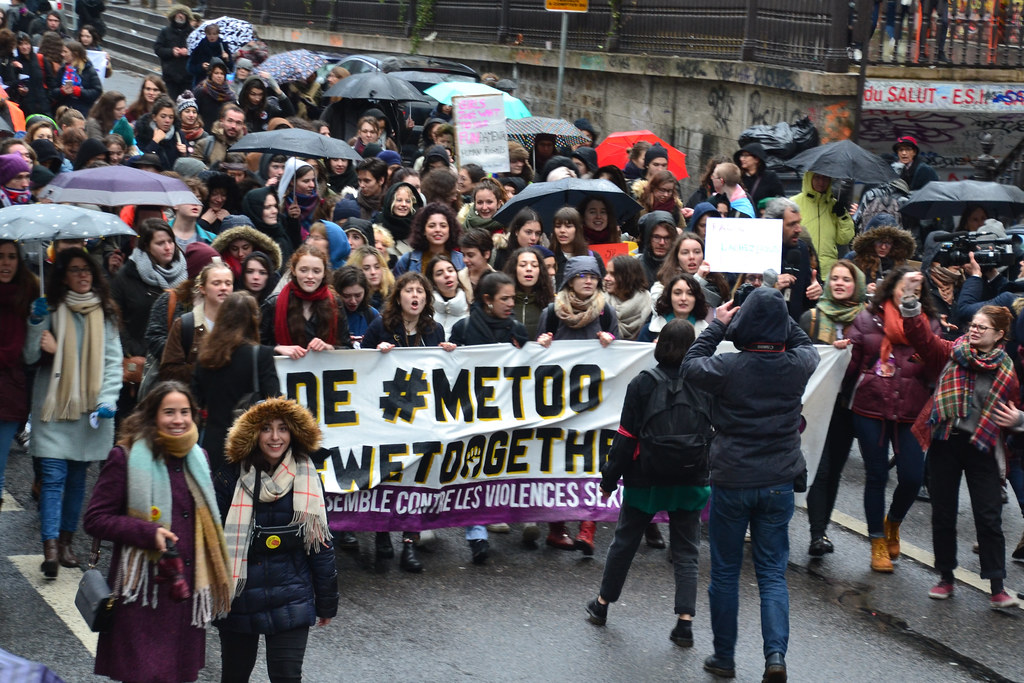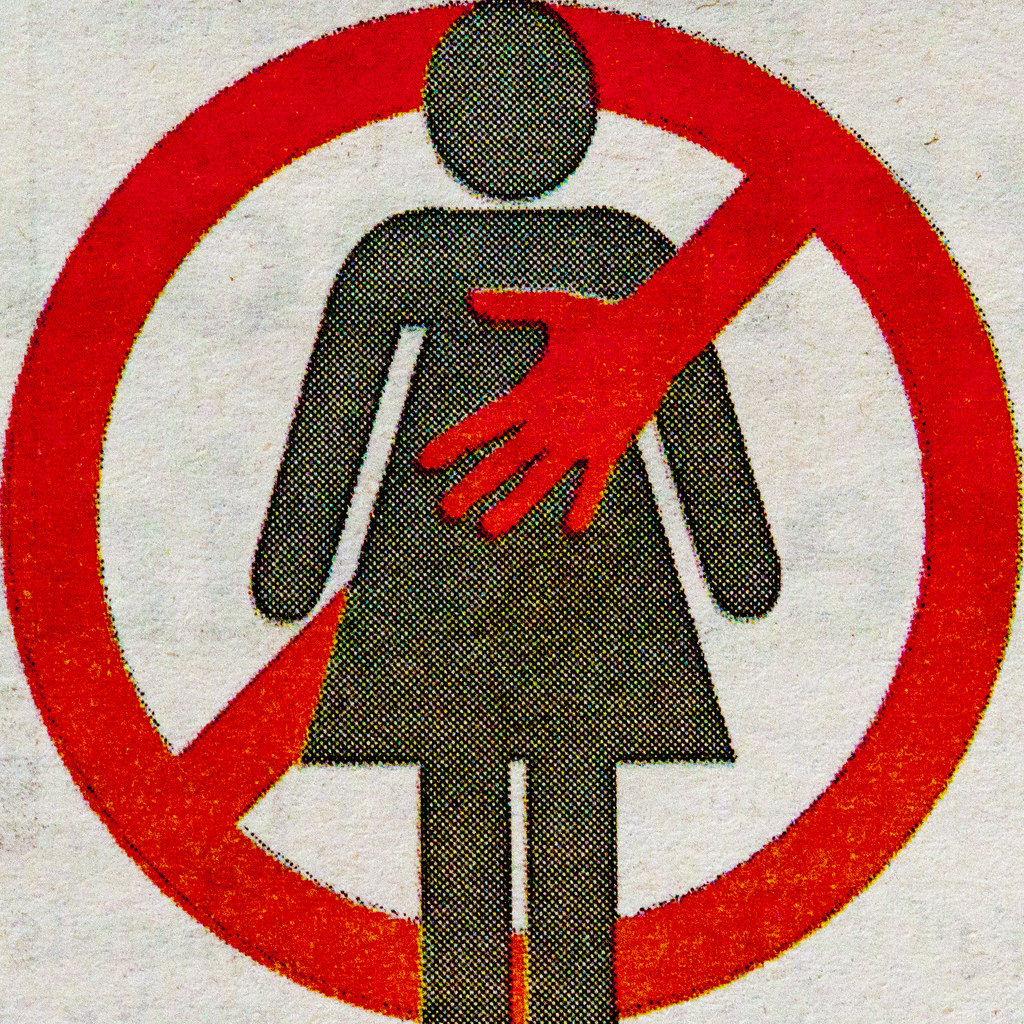
de #metoo à #wetogether” by Jeanne Menjoulet is licensed under CC BY-ND 2.0.
Introduction
The rapid advancement of digital technology is empowering women to access their rights through digital platform. The UN Women Executive Director Sima Bahous (2023) indicates that Digital rights are women’s rights. The convenience of media technology has enabled the global spread of women’s social movements and promoted digital feminism to a certain extent. Specifically, it empowers women who have been harmed to use it as a tool to advocate for their rights by speaking out. At the same time, digital media platforms have changed the traditional discourse landscape to allow vulnerable groups to speak out. Digital activism on social media has also expanded the development and influence of women’s social movements. Against this background, this article will use the #Me Too movement as a case study to analyze the role of Twitter and TikTok in women’s digital rights.
#Me too movementoriginated on Twitter and was created in order to raise awareness for the large number of women who face sexual assault and harassment. In 2006, Tarana Burke started the campaign to reach survivors of sexual assault in poor communities and it went viral in 2017. Between October 2017 and December 2019, there were over 24 million impressions using the #MeToo hashtag on Twitter and almost every region of the globe engaged in the movement.
Speaking out on social media is a main way of women’s struggle
Participation on the platform means the realization of digital rights.
Digital technologies have been regarded as an infrastructure for the realization and promotion of human rights more commonly (Kari, 2016). New media empower women who have experienced harm, enabling them to use the affordance of social media to assert their rights through speaking out. Women use their personal expression rights, posting their unfortunate experiences on Twitter. Users can take a stand for themselves by simply liking, commenting, or retweeting their interactions on content with the hashtag. Because of the timeliness and interactivity of social media, it is easy for users to share through hashtag. The rapid dissemination of information promotes the hot trend of the topic and attracts the attention and promotion of more viewers and celebrities. Due to the increasing social influence of the topic, relevant organizations and departments can pay attention to it. As Kari (2017) puts it, Internet access can be seen as a “derived human right” and its realization is increasingly dependent on the use of digital technology.
The #MeToo hashtag can be seen as a symbol of women’s struggle on real life presents on social media, which has significant impact on the international discourse. The participants include individuals, celebrities, politicians, and news sources all over the world. Martínez et al., (2021) point out that the three different countries in the Americas showed the peaks and troughs of the movement’s popularity on social media, such as #MeTooEscritoresMexicanos, gained traction on Twitter in 2019 and later became part of Mexico’s media agenda. Women speaking out on social media as a means of protest can promote the social influence of the event and defend their due rights.
The change of discourse pattern:
Social media has changed the traditional discourse landscape. Compared to the one-way messaging of traditional media, modern social media offers women an opportunity to express themselves more actively and interact with other users. The virtual space created by digital media expands the autonomy and openness of public participation. Women’s participation in social media enables them to have positive rights, thus changing the discourse pattern centered on male power. The new digital technologies are independent of geopolitical political, economic and legal systems, as a space for the natural equality and uncontrollable exchange of information and free exchange (Kreiss, 2015,; as cited in Kari, 2016). In other words, women are using the freedom of expression on social media to challenge existing power structures that subject them to inequality and discrimination. On twitter, one can find an immense number of #metoo Movement social media pages created by everyday users. Specifically, while many organizations have the ability to support this global movement, anyone with an active Twitter account can join and get involved. In this situation, the growing influence of social media platforms has helped women defend their rights and interests.
The role of social media in sex education for underage girls:
In addition, underage girls can also know through social media that they have the right to fight back in the face of harm. The # Metoo movement has also encouraged teenage girls to speak out and ask how they should respond when faced with sexual harassment. Similar videos about sexual assault posted by young women became popular in 2020. The new video is aimed at teenagers and focuses on sexual harassment. It calls attention to the prevalence of sexual harassment of teenage girls. The “Put a finger down: Sexual harassment edition” video has become the 2021 TikTok teen edition of the 2017 #MeToo movement. In some areas, underage girls may not have access to adequate sex education. Therefore, when they experience sexual harassment, they do not know how to respond properly. In Web 2.0, social media provides a platform for widespread dissemination of information and resources. The spread of the # Metoo movement provides an opportunity for these underage women to learn about sex education and encourage them to speak out when they are sexually harassed. The exclusive and diversity of Tik Tok and Twitter encourage teenagers to use hashtags to find and interact with others who have had similar experiences. The way ritual spreads brings women from different regions and ages together to support each other, and they are also more likely to stand up for themselves, stand up to sexual harassers, and feel empowered to say something in real life.

Digital activism
Social media platforms bring about the mediatization of movement participation and promotion, which makes its social influence play in a mediatization way. The #Metoo movement on social media can be seen as a kind of digital activism. Cyber-populism offers a unique opportunity to tap into civic issues, which means it can be politicized and turned towards popular mobilization against causing economic and social disruption (Hutchinson, 2019). The main reason why the # Metoo movement can be seen as digital activism is that it is a movement of women competing for proper voice and moral approval. It is undeniable that some users use some inflammatory words as a symbol to get the audience’s recognition when they speak out on this topic on social media. As Tarana Burke said, “Millions of people around the world are using the hashtag #MeToo to seek safety and solidarity. Survivors bring a world of possibilities to the fight to end sexual violence. Now we are moving beyond hashtags to build a culture based on consent and harm reduction. It is our moral duty”. Women create powerful lobbying campaigns on social media, forming public opinion and spreading it quickly, ultimately amplifying its impact in the real world.
Abuse of digital rights can reduce public support and the credibility of content. Celebrity support on social media undeniably has guided and driven the positive public opinion trends of the # Metoo movement. The actress Alyssa Milano used her Twitter account to encourage women who had been sexually harassed or assaulted to tweet the words #MeToo. In the last 24 hours, the hashtag had been tweeted nearly half a million times. Digital activism democratized feminism on social media. However, it may also exacerbate group antagonism and social conflict. The digital rights of women in the # Metoo movement should be to fight against oppressive rights and promote gender equality and women’s rights. Some people may publish false information on the platform through deception, concealment, and falsification to take advantage of the sympathy of the female community. They spread inaccurate and exaggerated statements through the platform to gain support and popularity in order to earn commercial interests and personal fame. The question of the meaning and realization of the right to communication in the old media and whether decision-makers should refrain from intervening or actively promote citizens’ right to different information is constantly debated (Kari, 2016). In a digital context, the number of policy and regulation issues and their complexity will only increase.
Conclusion
Digital human rights reflect the nature of human rights to a certain extent, because it gives digital human rights a sense of morality and dignity. The # Metoo movement has galvanized millions of women to speak out about the sexual violence they have experienced and brought greater social attention to gender inequality and power. The promotion of social movements by media platforms can achieve unlimited social effects. The development of social media has reconstructed the distribution of discourse power and enhanced the ideology of women’s rights. The #Me too movement also has significant reference significance for the online dissemination of other social movements.
References
#MeToo: Headlines from a global movement | Digital library: Publications. (n.d.). UN Women. https://www.unwomen.org/en/digital-library/publications/2020/08/brief-metoo-headlines-from-a-global-movement
Bathous, S. (2023, 5). Op-ed: Digital Rights are women’s rights. UN Women. https://www.unwomen.org/en/news-stories/op-ed/2023/05/op-ed-digital-rights-are-womens-rights
Hutchinson, J. (2019). Micro-platformization for Digital Activism on social media. Information, Communication & Society, 24(1), 35–51. https://doi.org/10.1080/1369118x.2019.1629612
Kari, K. (2016). Human rights and the digital. In The Routledge Companion to Media and Human Rights (pp. 95–103). Routledge.
Martínez, F., Pacheco, C., & Galicia, M. (n.d.). The #MeToo Movement in Twitter: Fighting Gender-Based Violence. In Information Technology and Systems (pp. 36–44). Springer International Publishing. https://doi.org/10.1007/978-3-030-68285-9_4
Hutchinson, J. (2019). Micro-platformization for digital activism on social media. Information, Communication & Society, 24(1), 35–51. https://doi.org/10.1080/1369118x.2019.1629612
Observations and Analysis of the #metoo Social Movement and Debate on Twitter – Participedia. (n.d.). Participedia.net. https://participedia.net/case/7999
Conversation, T. (2021, May 8). How a TikTok #MeToo trend has empowered teens to speak out about their experiences. TNW | Tiktok. https://thenextweb.com/news/how-a-tiktok-metoo-trend-has-empowered-teens-to-speak-out-about-their-experiences-syndication
Valenciagrace, 2013, Tik Tok <https://www.tiktok.com/@valenciagrace/video/6939484421158407429>
Mark Morgan Trinidad B, No harassing, Me too movement. (2018). Flickr. <https://www.flickr.com/photos/46102325@N06/41471664881>
Burke, T. (2022, October 12). Tarana Burke: What #MeToo Made Possible, 5 Years Later. Time. https://time.com/6221110/tarana-burke-me-too-anniversary/
Alyssa Milano, 2017, Twitter, <https://twitter.com/Alyssa_Milano/status/919659438700670976?ref_src=twsrc%5Etfw%7Ctwcamp%5Etweetembed%7Ctwterm%5E919659438700670976%7Ctwgr%5E943da09b66fdeae4de528c5416377d01c9548905%7Ctwcon%5Es1_&ref_url=https%3A%2F%2Fwww.wbur.org%2Fcognoscenti%2F2017%2F10>
Rob Kall, womensmarch2018 Philly Philadelphia -MeToo. (2018). Flickr. <https://flickr.com/photos/10814044@N06/24935568847>
